Inspection hatches for tiles: a review of the best designs and options for their arrangement
There are many plumbing fixtures installed in bathrooms, each of which is connected to water supply and sewerage systems.Siphons, taps, meters, hoses and pipes can ruin any interior, so many property owners try to hide them.
An excellent camouflage option is a tile inspection hatch. The main thing here is to choose a suitable design and install it correctly. Let's figure out what to look for when choosing an inspection hatch and what rules should be followed so that the installed structure will serve for a long time without complaints about its functionality.
The content of the article:
What functions do inspection hatches perform?
To disguise electrical and pipelines, as well as the space under the bathtub, special boxes are used, screens and other similar designs.
All of them perfectly cover unaesthetic nodes, but the need for access to communications remains. Audit niches are used for this purpose.
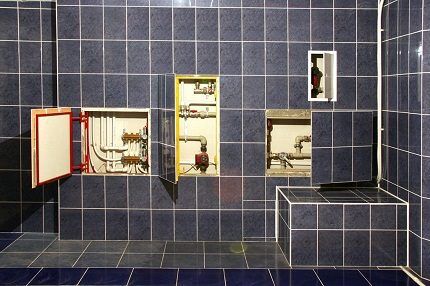
Some models of hatches for inspection niches are initially designed so that they can be covered with the same coatings that cover the walls: wallpaper, tiles or panels.
Such structures do not stand out against the background of the walls, which is why they are called invisible.
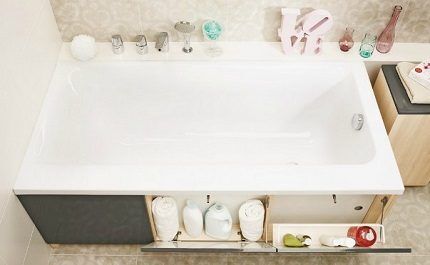
Sometimes niches in the walls serve to store a supply of hygiene products, washcloths, towels and other necessary supplies. They perform the functions of cabinets, but do not take up space in the bathroom.
Such storage niches are also covered with inspection hatches under the tiles, and they do not attract unnecessary attention.

Thanks to invisible hatches, you can give free rein to your design imagination and not worry that pipes or wires will hopelessly ruin the interior. They can be hidden and easily accessed if necessary. The main thing is to periodically carry out technical inspections so that pipeline leaks or meter breakdowns do not appear behind the beautiful facade.
Design features of the models
Hatches are installed in different parts of the room - in ceilings, walls, floors. In many ways, the design of each specific model depends on the intended location. Two main parts remain unchanged - the frame and the door; other elements can change depending on operating conditions.
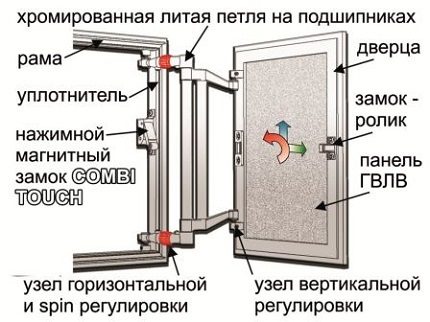
According to the size of the technical niche, they select and plumbing hatch model. They are usually 20x20-120x120 cm. The frame is firmly installed in the opening, and then the doors are mounted.Most often they are mounted on hinges, which can be made of metal or plastic (depending on the frame material).
There are two main types of frames:
- Adjustable. The owner can independently choose the size of the frame, and the excess material is simply cut off with a suitable metal tool.
- Unregulated. The size of the hatch is set during its manufacture and cannot be changed.
There are also frameless models. They are mounted using magnetic plates, and the main elements are fixed with silicone sealant or other suitable adhesives. Combined hatches are fixed using a frame and magnetic plates.

Inspection hatches are opened using suction cup handles. Push-type models are also common, which move away after pressing on the door plane.
Depending on the location of the niche, you can find a hatch that opens to the left or to the right. There are models that move in a vertical plane.
Inspection hatches are convenient designs that perfectly hide communication connection points without compromising freedom of access to them. They are easy to install and operate, and are reliable.
The structures do not require any special care: the surfaces of the doors can be washed with the same products that are used for walls.
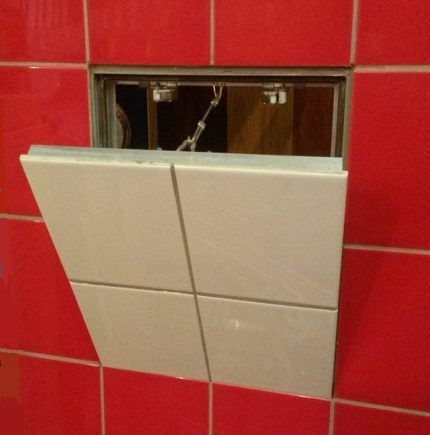
When using the inspection hatch, you only need to monitor the condition of the opening mechanism, lubricate it with machine oil in a timely manner and carry out minor repairs as necessary.Then the hatch will last as long as the wall decoration as a whole.
In some cases, you can even replace the tiles on the door surface if you carefully remove the old covering.
Opening mechanisms
Manufacturers install the following door opening mechanisms:
- swing;
- push;
- folding;
- sliding
Each type of opening has its own advantages. When choosing, you should focus on ease of use.
It is hardly possible to come up with a more convenient opening mechanism than a hinged one. However, an audit is often needed where access is difficult due to equipment or furniture. Then folding and sliding models come to the rescue.
If there is space on at least one side, then it is better to choose a sliding mechanism. And for areas with difficult access, folding structures with the ability to completely remove the door are more suitable.
The nuances of choosing the right hatch
When choosing a size, focus on the following parameters:
- Dimensions of a technical niche. The opening can be blocked or expanded a little, but in general the hatch must correspond to the niche, otherwise access to the equipment will be difficult.
- Door dimensions. The ratio of the parameters of the supporting frame and the hatch itself may be different. It is necessary to clearly determine how much space is required for a detailed inspection and repair of communications.
- Tile size. Wall finishing materials are usually purchased in advance, and this makes choosing a door easier.The tile should protrude beyond the surface of the hatch by 0.5-0.7 cm (or better, the maximum protrusion should be no more than 5 mm). It is also important that each tile is securely fastened: more than 60% of its area should be located on the hatch door.
For a spacious bathroom, you can choose a hinged hatch, but for a cramped one, a sliding or folding model is better.
If the opening of the inspection niche is located on a plasterboard partition or false wall, then you should give preference to a lightweight folding structure on an aluminum frame.

There are many manufacturers of inspection hatches whose products are worthy of attention.
The top three invariably include the following brands:
- «Phantom" The main advantage of hatches from this brand is their powerful, reliable hinges that can withstand significant loads. Even doors with heavy finishing do not sag over many years of use.
- «Hummer" A special feature of the Hummer models is their high-strength frames. The secret of their quality lies in the assembly features: the manufacturer uses argon-arc welding.
- «Glory" These are hatches with wear-resistant fittings that can withstand almost any weight of the finish. The doors of the models can be lined with ceramic tiles and even natural stone. They are not deformed.
The range of invisible hatches is extensive, and there is sure to be a suitable model for every inspection niche. It is important not to save money and buy a structure with a durable frame and good fittings.
Sometimes large technical niches are made, for example, if it is necessary to disguise a boiler, distributor, filter, meter, cold and hot water collector or other equipment behind a false wall. Often a large inspection niche is required in a toilet or combined bathroom for sewerage maintenance. If you cannot find a hatch of suitable sizes, you can resort to other ways to disguise communications.
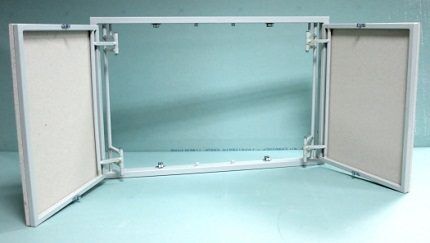
If the opening width exceeds 70 cm, you can choose a single-door hatch with a durable frame and a powerful opening mechanism, but it is better to opt for a two-door model. Most often, such hatches are equipped with push or swing opening mechanisms.
In the second case, the kit additionally includes suction cup handles.
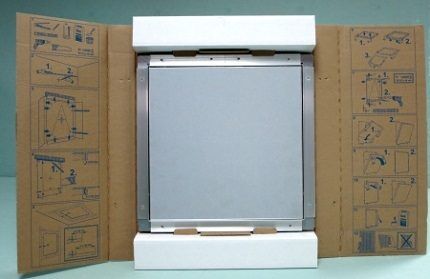
The maximum size of the standard two-door model is 120 x 160 cm, but an even larger hatch can be ordered if required. In this case, you should decide in advance on the size of each door.
They are calculated depending on the chosen tile: it is necessary that when opening the doors they do not cling to each other, but at the same time they are beautifully decorated with finishing material.

As for door materials, when choosing two-door inspection hatches it is better to give preference to models made of moisture-resistant gypsum fiber board. The option of drywall should not even be considered, because... it will not withstand heavy loads, will quickly deform and fail. Its only advantage is its low cost.
Instructions for installing a hatch under tiles
Work on installing an inspection hatch can be divided into several stages:
- Preparing the opening.
- Installation of frame with doors.
- Finishing the outer surface of the doors.
- Finishing work.
Each stage involves several types of work. To avoid any difficulties, we offer useful installation tips with illustrations:
After installation, all that remains is to make sure that the hatch functions normally, the seam is neat, and the tiles do not cling to anything when opening the door. If everything is in order, the structure is completely ready for use.
Conclusions and useful video on the topic
When purchasing and installing an inspection hatch under a tile, many factors should be taken into account. To avoid confusion and successfully complete the task, check out the useful video materials on the topic.
The video is dedicated to the variety of designs and mechanisms for opening hatches:
Correctly calculating the size is the most difficult task when choosing a suitable model. Listen to the specialist's recommendations:
Anyone who has learned to hold tools in their hands can handle the installation of a hatch. However, there are several points that deserve special attention:
The need for inspection hatches arises infrequently: preventive inspections are carried out every few months. But it is these simple designs that help out in difficult situations when you urgently need to fix a leak, clean a siphon or replace a meter.
Thanks to invisible hatches, you can beautifully decorate your interior without focusing on the elements that ensure its functionality.
Are you choosing an inspection hatch, but have not yet made your final decision? Or do you already have experience using similar structures and can you give valuable advice to our readers? Please leave comments on this material and ask questions on the topic in the block below.




We were renovating the bathrooms and were faced with the need to make a hatch in the toilet and a box in the bathroom. The process turned out to be quite labor-intensive. And the craftsmen charge much more for the manufacture of such structures than for laying tiles. But it also provides significant convenience. Now the voids are covered, there is access to the meters, everything is civilized, and all sorts of small things can be stored.
Andrey, such a hatch or door is not difficult to make yourself. I installed it because my husband was busy with other work.
At a hardware store I bought a plastic frame of the required size with a door, placed it in the opening with construction glue, or cement could be used. I glued a tile on top of the door, which only had to be pre-cut to size. All the work is done faster than going to the store.
It is very convenient when this inspection hatch has shelves for storing cleaning chemicals; this is exactly what we plan to do in our new apartment.If you are making a hatch out of tiles, I advise you to make a supply of these tiles. The fact is that our hatch was made from one large solid tile and was simply removed. And one day he somehow fell unsuccessfully and a piece of the tile broke off. If there was a supply of tiles, it would be possible to replace them without any problems.
Of course, such technological holes are very convenient both from the point of view of decorative elements, and additional space is created. It’s bad that in old-style houses (Soviet times) little thought was given to aesthetics, and this simply wasn’t done. That is why I really want a private house, where every square meter will be done my way, and nothing else.
Sasha, in Khrushchev buildings you can (and should) install such hatches yourself. Under the bathtub, behind the toilet in the toilet, where all the pipes go. And the view is better, and a lot of shelves are formed for storage.